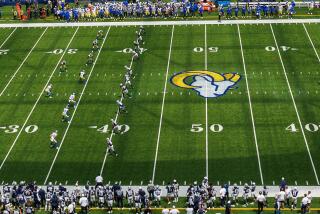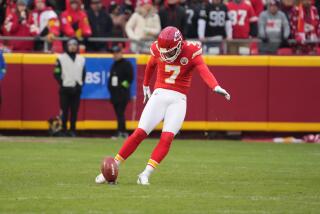Trying to Stop a Holding Pattern
- Share via
Another season, another chance for the NBA to confront the malaise that has befallen its once high-flying game.
Teams are scoring as if it’s the 1950s and offenses resemble, well, as one league executive says: “Three guys standing around on one side and the other guys standing in the parking lot on the other side, not participating.”
But for all the summer talk of radical maneuvers--changing the shape of the lane, allowing zone defenses--the NBA begins the 1999-2000 season with a set of lesser rule changes and modifications.
“Our game was becoming too physical,” said Rod Thorn, an NBA senior vice president. “The grabbing, clutching, impeded progress and the chucking were becoming rampant. We had to do something about it.”
The league has pinned its greatest hopes on tightening the rules governing physical contact. That means blowing the whistle when big men bang too hard under the basket. It means eliminating the sea of hands and arms that, say, Reggie Miller must wrestle through as he comes off a screen.
“We needed to do something to make our game more fluid, to make our game a game of movement,” Thorn said.
In another change, defenders will no longer be permitted to plant their forearms into the backs of ballhandlers, at least not above the free-throw line.
It amounts to a more hands-off policy on defense, a change that doesn’t sit well with players such as Charlotte Hornet forward Anthony Mason, who has complained: “They’re trying to make the game more sissified.”
Officials are more enthusiastic.
“I had one-on-one conversations with all the veteran officials,” said Ed Rush, director of officiating. “Every one of them bought into this as a tremendous opportunity for us to be part of the solution.”
But not all of the changes are directed at defenders. The league is putting some of the onus on offense.
Ballhandlers who are below the free-throw line and have their back to the basket get only five seconds to pass, shoot or pick up their dribble. No more inching backward toward the rim, wearing down the clock.
To no one’s surprise, this five-second limit has been dubbed the “Charles Barkley Rule,” but you won’t hear complaints from the man himself.
“I’m just glad people are going to remember me when I’m dead,” Barkley said.
Shot-clock rules have changed too. After certain stoppages of play, such as kicked or punched balls or personal fouls that do not result in free throws, the clock will be reset to 14 seconds rather than 24 seconds.
And the illegal defense rule has been lightened: It no longer applies to defenders on the strong side of the court.
These modifications follow unsuccessful attempts to increase scoring by moving the three-point line closer, then farther away.
When scoring continued to decline--dropping to 91 points per team a game last season, its lowest point since the shot clock was introduced in 1954--the NBA convened a blue-ribbon panel.
The recommended changes have brought results, both good and bad, in recent summer league and exhibition games.
Scoring has increased seven points a game over this time last year, the league said. But games are lasting slightly longer because teams are committing more fouls.
There have been exhibition games with 60, 70 and even 80 fouls. This point is not lost on NBA executives.
“Obviously there are a few who think there are too many ticky-tack fouls at this time,” Thorn said. “But the vast majority think we are on the right track.”
And the league shows no signs of turning back.
“Players don’t want to sit on the bench with fouls,” Thorn said. “If they see we’re serious about what we’re doing . . . the players, especially the good players, will adapt.”
(BEGIN TEXT OF INFOBOX / INFOGRAPHIC)
NBA Gets Tough on Contact
NBA officials will crack down on physical contact this year to generate more scoring. Here is a look at four things referees will no longer tolerate:
More to Read
Go beyond the scoreboard
Get the latest on L.A.'s teams in the daily Sports Report newsletter.
You may occasionally receive promotional content from the Los Angeles Times.











